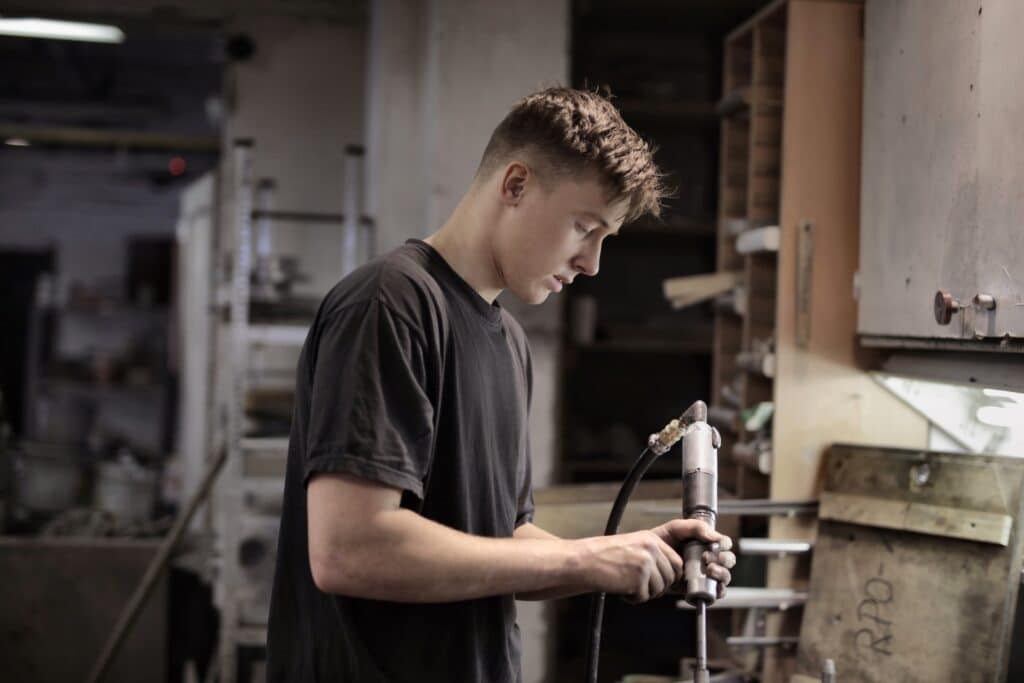There are many people who contribute when it comes to making an end product but assemblers are the ones who put it together and filter out any non-functional or odd parts, so the customers can use the end product as soon as they lay their hands on it.
Hiring the right assemblers is not only about finding individuals with technical proficiency; it’s about identifying those who possess a unique blend of problem-solving skills, attention to detail, and a commitment to precision. This blog dives deep into the art of hiring assemblers who can navigate the challenges of the assembly line with finesse and dedication.
Understanding the role of an assembler
In the intricate world of manufacturing and production, the role of an assembler holds a vital position. Assemblers are the skilled professionals responsible for piecing together various components to create finished products, ranging from electronics and machinery to consumer goods. The essence of an assembler’s role lies in their ability to meticulously follow instructions, interpret technical diagrams, and ensure that each part aligns perfectly with the whole.
Precision and attention to detail are the cornerstones of an assembler’s responsibilities. Their hands-on work involves using an array of tools and equipment to connect parts, fasten screws, solder wires, and perform other intricate tasks that ultimately culminate in a functional product. Beyond mechanical skills, assemblers must possess a keen eye for identifying defects or irregularities in the components they work with, ensuring the end result meets quality standards.
As technology continues to advance, assemblers have adapted to work with both traditional mechanical components and modern electronic elements. This requires a versatile skill set that encompasses not only mechanical finesse but also an understanding of circuits, microcomponents, and intricate wiring systems.
In essence, the assembler is the unsung hero of the manufacturing process, transforming individual pieces into products that shape industries and consumers’ lives. Their role requires a blend of technical proficiency, patience, and dedication to producing flawless end products that stand as a testament to their craftsmanship.
Identifying necessary skills and qualifications
The role of an assembler demands a unique skill set that combines technical prowess with attention to detail. As you embark on the journey to hire an assembler, it’s crucial to identify the essential skills and qualifications that will ensure the success of your manufacturing processes.
Technical Proficiency: Assemblers should possess a solid understanding of mechanical and electrical components. They must be adept at using a range of tools, from basic hand tools to more specialized equipment.
Blueprint and Schematic Reading: The ability to interpret technical diagrams, blueprints, and schematics is paramount. This skill ensures accurate assembly and alignment of components.
Fine Motor Skills: Assembling intricate products requires steady hands and precision. Assemblers must be able to handle small parts and perform delicate tasks with dexterity.
Attention to Detail: The devil is in the details, especially in assembly. A keen eye for spotting defects, misalignments, or irregularities ensures the final product meets quality standards.
Problem-Solving: Assemblers encounter challenges that require on-the-spot solutions. A knack for troubleshooting and finding creative solutions is indispensable.
Time Management: Meeting production targets requires efficient time management. Assemblers should be capable of working under deadlines without compromising quality.
Safety Awareness: Working with tools and machinery demands a strong sense of safety. An assembler should be well-versed in safety protocols to prevent accidents.
Communication: Clear communication is vital for collaborative work environments. Assemblers should be able to communicate effectively with team members, supervisors, and quality control personnel.
By pinpointing these skills and qualifications, you’ll be better equipped to find assemblers who not only fit the technical requirements but also contribute to the overall success and efficiency of your manufacturing operations.

Crafting a clear job description
A well-crafted job description is the cornerstone of attracting qualified assemblers to your team. It serves as the first point of contact for potential candidates, providing them with a comprehensive understanding of the role’s expectations and responsibilities.
Position Title: Assembler
Location: [Your Company Location]
Job Description: We are seeking a skilled and detail-oriented Assembler to join our dynamic manufacturing team. As an Assembler, you will play a pivotal role in turning individual components into high-quality finished products. Your precision and technical expertise will contribute to our commitment to delivering excellence to our customers.
Responsibilities:
- Read and interpret technical diagrams, blueprints, and schematics to assemble products accurately.
- Use a variety of tools and equipment to piece together mechanical and/or electronic components.
- Inspect and identify defects, ensuring all products meet quality standards before delivery.
- Collaborate with team members to troubleshoot and solve assembly-related challenges.
- Adhere to safety protocols and guidelines to create a safe working environment.
- Maintain a clean and organized workspace, optimizing efficiency and productivity.
- Contribute to continuous improvement efforts by providing insights and suggestions for process enhancement.
- Meet production targets and deadlines while upholding the highest level of craftsmanship.
Qualifications:
- High school diploma or equivalent; technical certification in assembly or related field is a plus.
- Proven experience as an assembler in a manufacturing or production environment.
- Strong blueprint reading skills and proficiency in using various hand and power tools.
- Detail-oriented mindset with exceptional problem-solving abilities.
- Effective communication skills and the ability to work collaboratively in a team setting.
- Prioritization skills to manage time effectively and meet production goals.
- Demonstrated commitment to workplace safety.
Join our team and be part of a company that values quality, innovation, and teamwork. If you thrive in a dynamic environment and possess the skills we’re looking for, we encourage you to apply and contribute to our mission of excellence in manufacturing.
Sourcing candidates effectively
Finding the right assemblers for your team requires a strategic approach to candidate sourcing. To ensure a pool of qualified candidates, consider employing a combination of online and offline methods that target both active and passive job seekers.
1. Online Job Boards: Utilize popular job boards and specialized industry websites to post your job opening. Include specific keywords related to assembly and manufacturing to attract relevant candidates.
2. Social Media: Leverage your company’s social media platforms to share the job posting. Engage with industry-related groups and communities to reach potential candidates directly.
3. Recruitment Agencies: Collaborate with recruitment agencies that specialize in manufacturing roles. They have access to a network of skilled candidates and can help match your requirements.
4. Networking Events: Attend industry-specific trade shows, workshops, and seminars. These events provide opportunities to network with professionals who might be seeking new opportunities.
5. Employee Referrals: Encourage your current employees to refer potential candidates from their network. Employee referrals often result in high-quality candidates who align with your company culture.
6. LinkedIn Search: Utilize LinkedIn to search for assemblers with relevant skills and experience. Reach out to potential candidates directly through personalized messages.
7. Company Website: Create a dedicated “Careers” section on your company website where candidates can easily find and apply for open positions.
8. Local Institutions: Partner with technical schools, colleges, and vocational training centers to tap into emerging talent. These institutions often produce candidates with the necessary skills for assembly roles.
By diversifying your candidate sourcing methods, you increase the chances of attracting a diverse pool of qualified assemblers. Remember to communicate your company’s values, growth opportunities, and commitment to employee development to make your job opening more appealing.
Screening and interviewing techniques
Screening and interviewing candidates for the assembler role requires a structured approach that assesses both technical skills and cultural fit. Follow these techniques to identify the best-suited individuals for your team:
1. Initial Resume Screening: Begin by reviewing resumes for relevant experience, certifications, and skills. Shortlist candidates who meet the basic qualifications.
2. Phone Screening: Conduct brief phone interviews to gauge candidates’ communication skills, enthusiasm for the role, and alignment with the company’s values.
3. Technical Assessment: Administer practical tests that mimic assembly tasks candidates will encounter on the job. Evaluate their accuracy, attention to detail, and ability to follow instructions.
4. Behavioral Interviews: Ask candidates about past experiences that showcase their problem-solving, teamwork, and adaptability. Use the STAR (Situation, Task, Action, Result) technique to delve into their abilities.
5. Job Simulation: Create a simulated work environment where candidates demonstrate their assembly skills. Observe their techniques, efficiency, and adherence to safety guidelines.
6. Panel Interviews: Organize interviews with a panel of team members, supervisors, and managers. This approach provides diverse perspectives on the candidate’s suitability.
7. Cultural Fit Assessment: Evaluate how well candidates align with your company culture by asking about their work style, values, and long-term career goals.
8. Reference Checks: Contact references provided by the candidates to validate their work history, reliability, and performance.
Throughout the screening and interviewing process, ensure clear communication about the role, expectations, and growth opportunities within your organization. By employing these techniques, you’ll identify assemblers who not only possess the required technical skills but also resonate with your team’s dynamics and goals.

Assessing problem-solving and attention to detail
Assembling intricate products demands problem-solving abilities and an unwavering attention to detail. To ensure you hire assemblers who excel in these critical areas, incorporate the assesmbler assessment and the following assessment techniques into your hiring process:
1. Task-based Scenarios: Present candidates with real-world assembly scenarios that require them to identify and troubleshoot potential issues. Evaluate their approach, decision-making process, and creativity in finding solutions.
2. Puzzle Challenges: Integrate puzzle challenges that mirror assembly intricacies. Assess how candidates tackle complex patterns, showcasing their spatial understanding and attention to detail.
3. Defect Identification Test: Provide candidates with a partially assembled product containing deliberate defects. Gauge their ability to identify errors and explain how they would rectify them.
4. Precision Assessment: Have candidates work on a task that requires precise measurements and alignment. Evaluate their accuracy in executing tasks that demand meticulous attention to detail.
5. Simulation Exercises: Use simulation software or hands-on activities to replicate assembly processes. This allows candidates to showcase their problem-solving skills in a controlled environment.
6. Interview Scenarios: Present hypothetical assembly challenges during interviews. Observe candidates’ problem-solving methodologies and their ability to communicate their thought processes.
7. Behavioral Questions: Ask candidates to share instances from their previous roles where their attention to detail and problem-solving skills made a significant impact. Probe into the steps they took to address challenges.
8. Role-specific Situations: Tailor assessment exercises to the specific assembly tasks they will encounter in your organization. This gives you insights into their ability to handle challenges unique to your industry.
By incorporating these techniques, you can effectively evaluate candidates’ problem-solving prowess and attention to detail. Remember that assembling products flawlessly requires not only technical proficiency but also the ability to navigate complex scenarios with precision and creativity.
Checking references and work history
Verifying the references and work history of potential assemblers is a crucial step in the hiring process. It provides valuable insights into a candidate’s work ethic, reliability, and compatibility with your team. Follow these steps to conduct thorough reference checks:
1. Contacting Previous Employers: Reach out to the candidate’s former supervisors and colleagues to inquire about their performance, teamwork skills, and adherence to deadlines.
2. Assessing Reliability: Ask references about the candidate’s punctuality, attendance record, and consistency in meeting job responsibilities.
3. Work Quality: Inquire about the candidate’s attention to detail, precision in assembly tasks, and their ability to produce high-quality work.
4. Team Collaboration: Gain insights into how well the candidate collaborated with colleagues, handled conflicts, and contributed to a positive team environment.
5. Initiative and Problem-Solving: Ask references if the candidate showed initiative in taking on additional responsibilities and their capability to solve challenges independently.
6. Communication Skills: Assess the candidate’s communication abilities, both in conveying information clearly and actively listening to instructions.
7. Cultural Fit: Inquire about the candidate’s compatibility with the company culture, as well as their adaptability and willingness to learn.
8. Honesty and Integrity: Ask references if they can vouch for the candidate’s honesty, ethical behavior, and integrity in the workplace.
By thoroughly checking references and work history, you can validate the information provided by the candidate and gain a comprehensive understanding of their suitability for the assembler role. These insights contribute to a well-rounded assessment and assist in making an informed hiring decision.
Offering competitive compensation and benefits
When seeking to hire top-tier assemblers, providing an attractive compensation package is essential to not only attract but also retain skilled talent. A well-structured compensation plan demonstrates your commitment to valuing their contributions. Consider the following strategies to offer competitive compensation and benefits:
1. Market Research: Conduct thorough research to understand the prevailing compensation rates for assemblers in your industry and region. This ensures your offer aligns with market standards.
2. Base Salary: Offer a competitive base salary that reflects the candidate’s experience, skills, and the complexity of the assembly work they’ll be performing.
3. Performance Incentives: Consider implementing performance-based incentives or bonuses tied to meeting production targets, maintaining quality standards, or other key performance indicators.
4. Benefits Package: Provide a comprehensive benefits package that includes health insurance, retirement plans, and paid time off. A strong benefits offering can significantly enhance the overall compensation package.
5. Career Development: Highlight opportunities for career growth and skill enhancement within your organization. Emphasize the potential for advancement to attract candidates seeking long-term commitments.
6. Flexible Work Arrangements: If feasible, offer flexible work arrangements, such as remote work options or flexible hours, to accommodate candidates’ preferences.
7. Recognition Programs: Implement recognition programs that acknowledge and reward outstanding performance. Acknowledging the importance of their contributions can foster loyalty and motivation.
8. Employee Feedback: Regularly seek feedback from your assemblers regarding their compensation and benefits. This demonstrates your willingness to listen and adapt to their needs.
Remember that a competitive compensation and benefits package goes beyond the monetary aspect; it communicates your company’s dedication to nurturing a supportive and rewarding work environment. By offering an enticing package, you increase your chances of attracting assemblers who are not only skilled but also motivated to excel within your organization.
Conclusion
In the realm of manufacturing, the role of an assembler is more than just a job; it’s a craft that requires a perfect harmony of skills, dedication, and precision. By understanding the nuances of the assembler’s responsibilities, identifying essential skills, and implementing effective screening and interviewing techniques, you can build a team of individuals who excel in turning raw components into remarkable products.
Remember, the heart of successful assembly lies in the hands of these skilled professionals. With careful consideration of their unique qualities and a commitment to offering competitive compensation and benefits, you can create an environment where assemblers thrive and contribute significantly to the success of your manufacturing endeavors. As you embark on the journey of hiring assemblers, keep in mind the insights shared in this blog, and you’ll be well on your way to building a team that shapes the future of your industry.
Testlify offers a range of assessments and challenges that allow you to gauge candidates’ knowledge, problem-solving skills, and creativity in real-world scenarios. With Testlify, you can administer real-world challenges that simulate the actual assessment process, giving candidates the opportunity to showcase their skills and approach. The platform provides a structured and standardized assessment process, allowing you to compare candidates objectively and make informed decisions. By incorporating Testlify into your hiring process, you can ensure a more comprehensive and reliable evaluation of candidates’, ultimately helping you identify the most qualified individuals for your team.
With our extensive test library, you can objectively evaluate candidates’ abilities, ensuring you shortlist the most talented individuals efficiently. Ready to unlock the potential of your hiring process? Book a free 30-minute live demo with Testlify. Our expert team will guide you through the platform, showcasing relevant skill tests tailored to your organization’s needs. With our support, you can streamline candidate selection, saving valuable time and resources.







